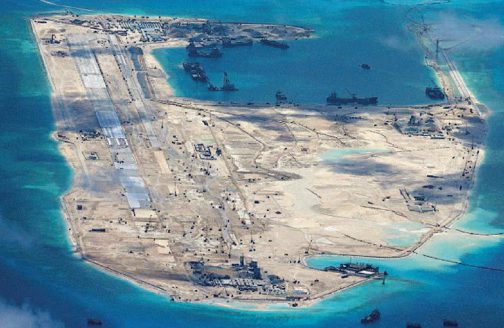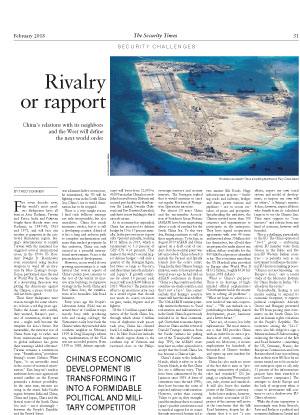China’s relations with its neighbors and the West will define the next world order

For seven decades now, the world’s most perilous flashpoints have all been in Asia: Kashmir, Taiwan and Korea. India and Pakistan fought three bloody wars over Kashmir, in 1947-48, 1963 and 1971, and still face one another at gunpoint in the contested Himalayan region. Beijing’s determination to reunify Taiwan with the mainland has triggered several international crises; in the 1950s US President Dwight D. Eisenhower even considered using nuclear weapons to ward off an invasion by Mao Zedong’s troops. Korea, partitioned since the end of World War II, was the scene of a devastating three-year war pitting the Americans against the Chinese; a peace treaty has still not been signed.
These three flashpoints were reason enough for some observers to hoist a red flag years ago. Unless the Asians were careful, they warned, Europe’s past – one of contention, rivalry and war – might well become the template for Asia’s future. But meanwhile, the meteoric rise of China from rags to riches and from international impotence to global influence has given their warnings added relevance. Taiwan remains a contentious issue. “Reunification,” postulates Beijing’s recent Defense White Paper, “is an inevitable trend in the course of national rejuvenation.” Kim Jong-un’s nuclear ambitions have once again made armed conflict on the Korean peninsula a distinct possibility. At the same time, tensions are rising in the entire Indo-Pacific region: between India and China, China and Japan, China and the littoral states of the South China Sea and – most alarmingly – between the People’s Republic and the United States.
“China’s economic development is transforming it into a formidable political and military competitor,” writes Graham Allison, the founding dean of Harvard’s Kennedy School of Government. In 2015 he asked: “The Thucydides Trap: Are the US and China headed for War?” Writing about the conflict that devastated Athens and Sparta 2,500 years ago, he concluded: “When a rising power threatens to displace a ruling power, alarm bells should sound: danger ahead.” Reviewing the past five hundred years, he found sixteen cases in which a major nation’s rise disrupted the position of the dominant state. Twelve of these rivalries ended in armed conflict. Allison granted that war between the US and China is not inevitable, but expanding his thesis into a book last year, he entitled it Destined for War.
Others took up the idea. The Rand Corporation published a 96-page study by David Gompert War with China. Thinking the Unthinkable. John Davis chimed in with his analysis “How would a war between the US and China play out?” Steve Bannon, President Trump’s erstwhile adviser, was adamant: In five or ten years, he maintained, the US will be fighting a war in the South China Sea; China’s rise to world domination has to be stopped.
There is a very simple reason I find such bellicose musings not only irresponsible, but also unrealistic. China has made enormous strides, but it is still a developing country. Ahead of it lies a long and arduous path to complete modernization and more than modest prosperity. In this endeavor, China can only succeed in a peaceful international environment. Peace is the precondition of development.
However, in our world of ever growing uncertainties it is only natural that several aspects of China’s policy pose concerns to the rest of the world: its massive arms build-up; its expansive strategy in the South China and East China Seas; the ramifications of its boundless Silk Road Initiative.
Forty years ago the People’s Liberation Army (PLA) was an armed force of 5 million troops mostly busy with producing tofu and raising cabbage; the Vietnamese easily beat back the Chinese when they invaded their southern neighbor in February 1979. In Deng Xiaoping’s reform era, modernization of the PLA was not accorded priority. From 1979 to 1989, defense expenditure dropped by 6 percent annually. But then the US-led wars in Iraq, with Serbia and against the Taliban in Afghanistan convinced the leadership that they had a lot of catching up to do to turn the PLA into a modern force.
It was reduced to two million men. The PLA structure was totally revamped. Information, cyber and space warfare were emphasized. Territorial defense is no longer the only mission; “safeguarding China’s security and interests” in remote regions of the world and in “local wars” was added to the military portfolio.
Just as important was a fundamental revision of China’s strategic posture. The traditional view that the land is more important than the sea has been abandoned. The greatest importance, said the 2015 Defense White Paper, should henceforth be accorded to the seas and oceans as well as to safeguarding the security of China’s overseas interests. “Open seas protection” is being added to “offshore waters defense.” Small wonder, then, that the Navy as the ideal instrument of power projection has profited most from the increases in the defense budget; that the Marine corps will boost from 12,000 to 40,000 men; that China has established a naval base in Djibouti and secured port facilities in Hambantota (Sri Lanka), Gwadar (Pakistan) and Port Darwin (Australia); and that it is now building its third aircraft carrier.
As its economy has expanded, China has increased its defense budget by 10 to 17 percent annually. In the past two years it grew only 7 percent annually, reaching $151 billion in 2017, which is tantamount to 1.3 percent of GDP (US: 4.35 percent). That makes it the world’s second largest defense budget – still only a quarter of the Pentagon figure, but twice as large as Russia’s, and three times more than India’s and Japan’s. If growth continues by about 10 percent each year, it will reach $300 billion in 2025. What for? The pernicious effect is an enormous arms race in a world region that should not waste its scarce resources on guns, tanks, frigates and jet fighters.
Of the 3.3 million square kilometers of the South China Sea, through which about 5 trillion tons of shipborne trade passes each year, China has claimed back 2.6 million square kilometers. Its Nine Dash Line includes the whole region down to the southern top of Vietnam and eastward close to the Philippine coast. A large part of three island groups – the Paracels in the North, the Spratlys in the center and Scarborough Shoal in the east – are also being claimed by five other littoral states as well; many islands fall into the Exclusive Economic Zones of Vietnam, Malaysia, the Philippines, Taiwan or Brunei. In 2013, China’s President Xi Jinping gave the green light for the build-up of seven artificial islets around rocks or low-tide elevations normally under water. Although The Hague Arbitration Court rejected the Chinese claims as historically and legally unfounded, Beijing stuck to its view. Moreover, it started turning the seven islands into unsinkable aircraft carriers by building piers, runways for military aircraft, harbor facilities for its navy jets, hangars and radar towers; on some they are reported to have deployed artillery. When the United States protested against the “militarization” of those seven artificial islands, the Chinese defense ministry reversed the charge. China would further strengthen its naval and air defenses. It urged the US to respect the People’s Republic’s sovereign territory and security interests. The Pentagon replied that it would continue to carry out regular Freedom of Navigation Operations missions.
For almost 20 years China and the ten-member Association of Southeast Asian Nations (ASEAN) have been negotiating about a code of conduct for the South China Sea. To this very day, Beijing continues to stall on these negotiations. To be fair, in August 2017 ASEAN and China agreed on a draft code of conduct. But the essential point was left unresolved: China refused to include the Paracel and Spratly Islands into the code’s remit. Yang Jiechi, then Chinese foreign minister, seems to have prevailed. Several years ago he had told an ASEAN conference in Hanoi: “China is a big country and other countries are small countries, and that’s just a fact.” One cannot exclude that Beijing’s assertive stance will have the desired effect. The 13th ASEAN summit pointedly omitted references to “land reclamation and militarization” in the South China Sea previously included in its final communiqué. Given their economic dependence on China and the retreat of Donald Trump’s America from the Pacific (witness his pulling out of the Transpacific Partnership TPP), the ASEAN states may have no other option but to accept that the South China Sea has become a Chinese lake.
China’s claims to the Senkaku Islands, which it refers to as the Diaoyu Islands, in the East China Sea are a different story. They have been administered by the Japanese since 1895. A bone of contention since the mid-1990s, they have become the scene of repeated military confrontation. However, rather than causing Tokyo to give in, they strengthened the tendency there to amend Japan’s pacifist constitution and to marshal support for its stance through increased foreign aid as well as closer military cooperation with India, Australia, New Zealand and the United States.
Yida Yilu – One Belt, One Road – was the name given to the ambitious development project unveiled by China’s President Xi Jinping in 2013. At first it aimed only at the resuscitation of Marco Polo’s old Silk Road from China to Europe and the century maritime Silk Road between China and East Africa opened up by Admiral Zheng Sen in the 15th century. But as it has changed its label several times and now goes by the name Belt and Road-Initiative (BRI), it has also kept expanding its geographical scope. It now encompasses “all countries from either Asia, Europe, Africa or the Americas” (Xi Jinping). Even a “Polar Silk Road” has become part and parcel of the scheme.
The basic idea is connectivity and cooperation along the two ancient Silk Roads. Huge infrastructure projects – building roads and railways, bridges and dams, power stations and pipelines – are to create corridors of peace and prosperity. Spearheading the initiative, the Chinese invited more than 100 countries and organizations to participate in the enterprise. They have signed cooperation agreements with over 40 states and invested about 50 billion dollars themselves, but all told they are prepared to make almost one trillion dollars available for the 900 Silk Road projects identified so far. This is ten times more than the US Marshall plan provided to Europe after World War II ($13.2 billion, roughly $130 billion in 2018 dollars).
What is China’s purpose? There is no shortage of high-minded official explanations: “Development holds the master key to solving all problems” – “What we hope to achieve is a new model of win-win cooperation” – “We can embark on a path leading to friendship, shared development, peace, harmony and a better future.”
There are, of course, less lofty explanations. The most innocuous is that BRI provides China with an outlet for its excess production of steel, cement, solar panels etc. Moreover, it secures employment for hundreds of thousands of Chinese workers and opens up new markets for Chinese firms.
China has also made no secret of the fact that it aims at “promoting connectivity of policies, rules and standards” (Xi Jinping), i.e. replacing Western policies, rules, norms and standards. It will also boost the market power of the Chinese currency.
In the latest analysis, however, any realistic assessment of Xi’s project of the century will arrive at the conclusion that the Silk Road Initiative, despite his disclaimer that it is not “a case of outdated geopolitical maneuvering,” is quintessentially an exercise in geopolitics. Where the West insists on political and economic reforms, the People’s Republic uses its enormous capital reserves, its engineering knowhow as well as its production and building capacity to give globalization a Chinese face. It is welcome wherever money is in short supply and political stipulations regarding human rights or financial rectitude are unappreciated.
No matter how often and how loud Beijing’s spokespersons keep denying it China is creating for itself an old-fashioned sphere of influence that reaches far beyond the boundaries of its former tributary states. China seems to have internalized both of the classical theories of geopolitics: Halford Mackinder’s Heartland Theory, according to which whoever dominates the pivot area from the Volga to the Yangtze and from the Himalayas to the Arctic commands the world; and Admiral Alfred Mahan’s vision of sea power as the main attribute of national greatness.
“We have no intention to interfere in other countries’ internal affairs, export our own social system and model of development, or impose our own will on others,” is Beijing’s mantra. It does, however, expect all those who benefit from its calculated largesse to toe the Chinese line. They must support its “core interests” and refrain from any kind of criticism, however well founded.
This is a challenge, particularly to the EU. The China-sponsored “16+1” group – embracing eleven EU member states from Greece to the Baltic and five non-EU Western Balkan countries – is patently seen as an instrument to influence the internal EU decision-making process. “China is not just knocking on Europe’s door,” says a recent study of the Mercator Institute for China Studies in Berlin. “It’s already in the room.”
Undoubtedly, Beijing is not merely seeking to expand its economic footprint; it expects political compliance. Already Greece and Hungary prevented the EU from passing joint statements on the South China Sea and on human rights violations in the People’s Republic. The easterners among the “16+1” states also felt obliged to sign a Memorandum of Understanding endorsing the thrust of the Belt and Road Initiative – something the US, Germany, France, the European Commission and even Britain refused (one reason being that in their view BRI has by no means turned out to be an exclusive enterprise open to all; only 11 percent of the infrastructure projects have been awarded to non-Chinese companies.) The attempts to divide Europe and the lack of reciprocity when it comes to investments will continue to cast a shadow over EU-China relations.
While the Asian superpower is increasingly seen from Brussels, Paris and Berlin as a political and economic challenge in Central and Eastern Europe and on a wider global scale, it should not be ignored or forgotten that when it comes to climate change, free trade and the maintenance of peace in Asia, the Europeans and Chinese are sitting in the same boat. They are allies in the fight against climate skeptics and protectionists. And preserving peace is not only the precondition of China’s continued development, it is the only way to avert global chaos.
A China bent on reclaiming its past greatness must realize that others have core interests and core values, too; that the US will have to restrain President Trump’s impulse to unleash a preemptive strike against nuclear North Korea; and that Washington and Beijing should manage their disagreements and negotiate a long peace. Priority should be given to warding off the mega-threats of an atomic Armageddon, of anarchic nuclear proliferation, of global terrorism and of climate change.
All of them should, in Henry Kissinger’s words, “move from crisis management to a definition of common goals, from the solution of strategic controversies to their avoidance.”
THEO SOMMER
is executive editor of The Security Times and The German Times and a former editor-in-chief of the German weekly Die Zeit.




